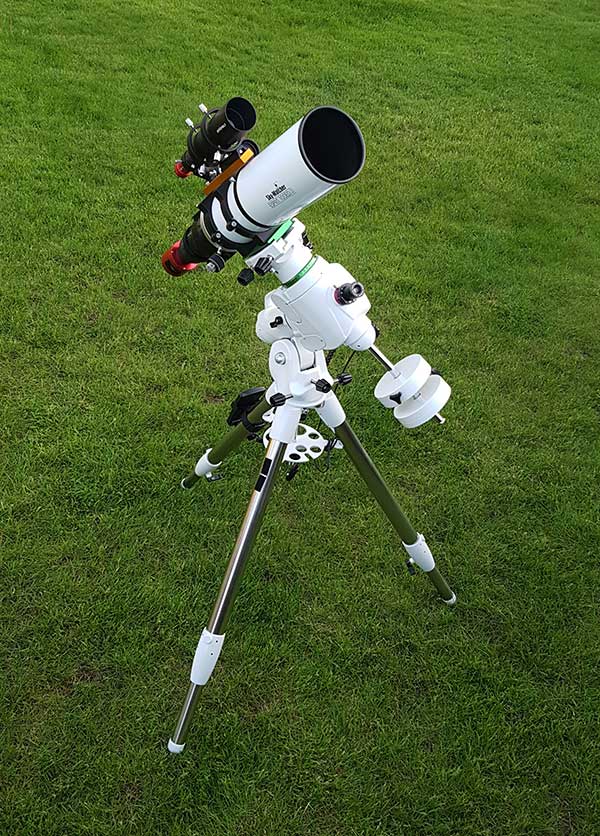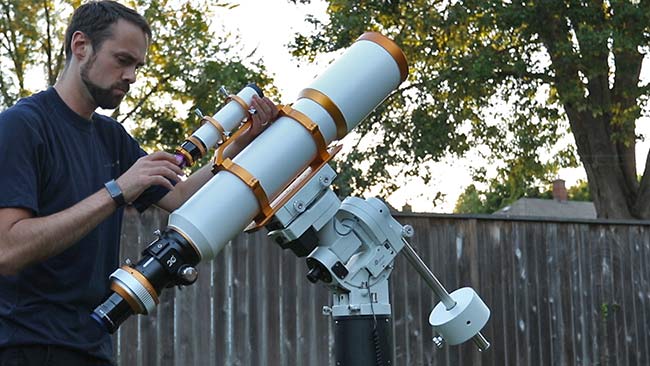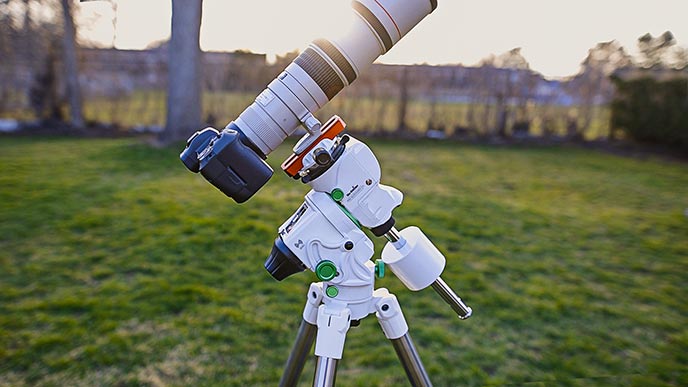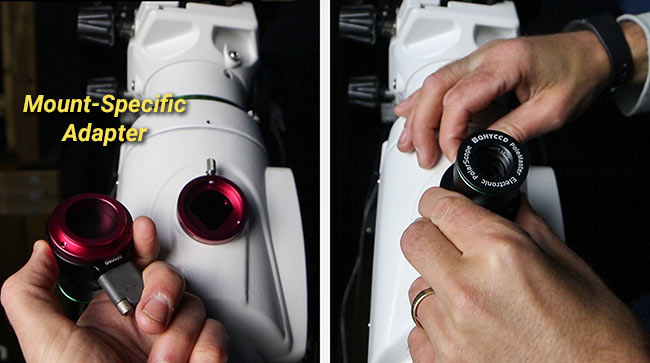Equatorial Telescope Mounts: The Basics
Amateur astronomy enthusiasts and astrophotographers rely on an equatorial telescope mount to track the apparent movement of the night sky. Whether you call it a computerized telescope, or a tracking telescope, it’s actually the mount that does the tracking, not the telescope itself.
There are many types of tracking telescope packages available, from fork-mounted all-in-one units (like the Celestron CPC series) to tracking GoTo mirror-based Dobsonian telescopes. But if your goal is to take deep sky astrophotography images with your camera, you’ll want to invest in a robust equatorial telescope mount.
A tracking telescope mount used for astrophotography.
With a computerized mount that is able to track the motion of the stars, the telescope you attach to it is up to you. Not only does a GoTo telescope mount make locating objects in the night sky easier, but it also allows you to take long-exposure images (without star trailing).
An equatorial telescope mount (often called a German equatorial mount, or “GEM”) that has been accurately polar aligned with the polar axis of the Earth can follow a particular object in the night sky for an extended period of time.
Because the Earth makes a full rotation on its axis every 24 hours, the night sky appears to slowly move throughout the night. For telescope observers and astrophotographers, this presents a challenge in terms of staying “locked on” a target.
A basic deep-sky astrophotography setup using an equatorial telescope mount.
For example, with a non-tracking telescope mount such as a traditional Dobsonian design, objects at high magnification appear to gradually drift by in the eyepiece. If you have ever looked at the moon up-close through a high powered telescope without tracking, you’ll know exactly what I mean.
When observing solar system objects in space such as planets or the moon, this is not much of a problem as you can easily move the telescope slightly to ” keep up” with your subject. This is also a non-issue for deep sky observations such as galaxies or star clusters, as the movement of the object is quite slow.
However, this movement makes long exposure astrophotography impossible. The gradual movement is enough to make your photograph blurry in as little as 1-2 seconds because depending on the focal length (magnification) used.
Deep sky astrophotography images captured on an equatorial telescope mount.
Manual Tracking vs. Motorized
A basic, lightweight equatorial mount and tripod can provide you with support and control of your small telescope. A manual equatorial mount will give you dual slow-motion controls in the RA and DEC axis, that you control by slowly turning the knobs on the mount.
For example, the Orion EQ-1 equatorial telescope mount pictured below requires you to manually control the axis of the mount to stay on your target. It is possible to add an electronic clock drive for motorized celestial tracking.
A mount like this is extremely affordable and can carry a small telescope of up to 7 lbs. If you plan on capturing astrophotography images, I would recommend saving up for an EQ mount with a built-in tracking motor. I anticipate many aspiring amateur astrophotographers will quickly outgrow a non-motorized equatorial mount.
The next logical step up from a manual EQ mount is one that includes a motorized clock drive, that allows you to take long-exposure photographs of deep sky objects in space. Mounts in this price range often include a “GoTo” database of celestial objects that are selected using an external hand controller.
When you are ready to invest in a mount with hands-free motorized tracking capabilities, I highly recommended purchasing one that includes a built-in polar finder scope. It boggles my mind that there are models out there that do not include this essential feature!
Equatorial Mount vs. Alt-Az Mount
Which telescope mount is best for astrophotography?
Astronomical telescopes can be mounted in two ways, EQ (equatorial), and Alt-Az (alt-azimuth). Both of these mount designs are extremely popular in the amateur astronomy community, and allow the use to freely point the telescope in two perpendicular directions (called axes). The alt-azimuth mount design simply allows you to move the telescope in altitude (up and down), and azimuth (left to right).
The iOptron Az Mount Pro is a practical choice for GoTo visual observing.
An Alt-Az mount (such as the iOptron Az Mount Pro shown above) is great for casually observing objects in the night sky, but is not suitable for deep sky astrophotography. The Alt-Az mount was designed for convenience and practicality, at the cost of precision tracking over long periods of time.
On the other hand, the German equatorial mount design has a right ascension (RA) axis, a declination axis (DEC), and a polar axis (the RA axis aligned with the celestial pole). The DEC axis moves the telescope north and south, and the RA axis moves the telescope east and west. The polar axis of an equatorial telescope mount must be pointed towards the north celestial pole, which is the point in the sky at which all of the stars appear to rotate around.
When an equatorial telescope mount is parallel to the Earth’s rotational axis, the sky’s apparent motion from east to west can be followed (tracked) accurately. The RA motor in an equatorial mount slowly moves in one motion to match this speed of motion for accurate long exposure astroimaging.
Recommended Equatorial Mounts for Astrophotography
Here is a helpful list of mounts that are suitable for deep sky astrophotography. All of these models are widely used in the astrophotography community and are behind some of the most beautiful images shared on Astrobin, Flickr, and Reddit.
Some of my favorite mounts I’ve ever used for astrophotography are the iOptron CEM60 and the Sky-Watcher EQ6-R Pro.
Beginner-Level
Intermediate Level
- Sky-Watcher EQ6-R Pro SynScan
- iOptron CEM60 Center-Balanced Equatorial Mount
Advanced
- Software Bisque Paramount MYT Robotic Telescope System
- iOptron CEM120EC Equatorial Mount
How an Equatorial Telescope Mount Works
An equatorial mount has one rotational axis parallel to the Earth’s axis of rotation. This design allows the attached instrument (your camera or telescope) to stay fixed on a celestial object by driving one axis at a constant speed. The equatorial axis is known as right ascension, while the perpendicular axis is called declination. The right ascension axis (RA), rotates in one revolution every (approximately) 24 hours.
The mechanical design of an equatorial mount is better suited for astrophotography than an altazimuth mount (alt-az). The latter will rotate the object in the focal plane, and generally have a harder time guiding the object.
For those interested in prime-focus astrophotography, a computerized equatorial telescope mount is essential. The internal motors allow the telescope mount to rotate at sidereal rate, (or “clock drive“) and match the exact speed of Earth’s rotation.
Right Ascension and Declination
If you have ever seen the terms “right ascension” (RA), or “declination” (DEC) before, you might be scratching your head as to what these terms are referring to.
An equatorial telescope mount operates on two axis, RA, and DEC.
Right ascension is the axis that rotates around the north or south celestial pole depending on which hemisphere you are located in. The telescope mount must be accurately polar aligned to match the rotation of the night sky in RA.
In order to balance the telescope correctly in the RA axis, a counterweight must be used for balance. Equatorial mounts usually include 1 or 2 counterweights as a package, depending on the payload capacity of the mount.
Balancing the telescope in the DEC axis is simply a matter of positioning the telescope at the right distance on the DEC mount so that it’s balanced from the front of the telescope’s objective lens to the camera.
Setting Circles
Setting circles consist of two graduated discs attached to the equatorial mounts RA and DEC axis. The RA (right ascension) disc is graduated into hours, minutes, and seconds, whereas the declination disc, is graduated into angular measurements (degrees, arcminutes, and arcseconds).
Setting circles are used in an equatorial mount to find astronomical objects in the night sky by using their equatorial coordinates. These coordinates can be a useful way to pinpoint objects on the celestial sphere and are often used in star charts.
Because the RA coordinates are fixed on the celestial sphere, the RA disc can be driven using a clock drive running in sidereal time. Today’s equatorial telescope mounts often use digital setting circles, consisting of two rotary encoders on both axis. They measure the angle that the telescope is pointing, displaying the coordinates in digital format.
The Celestial Sphere
The celestial sphere is an imaginary sphere used for astronomy and navigation purposes. All of the objects in your current observable sky can be thought of as “projections” on the inside surface of the celestial sphere. This is a practical method of plotting objects in space using the equatorial coordinate system.
The German Equatorial Mount
The primary structure of a GEM is a T-shape, with the right ascension axis at the lower diagonal position, and the declination axis on top. The telescope is placed on the DEC axis, with a counterweight attached at a balanced position on the other end.
A GEM is the best possible choice for long-exposure astrophotography. In recent years, a new take on the German equatorial mount design has surfaced. The image below shows a new center-balanced design from iOptron, the CEM40.
When the telescope is able to secure a target in place for hours at a time, you can then attach your camera and collect several long exposure images. This is essentially what deep sky astrophotography is all about, and almost every other aspect is geared towards improving this tracking accuracy with techniques such as autoguiding.
Equatorial telescope mounts come in many shapes and sizes, each having their own qualities in terms of maximum payload capacity and tracking performance.
Related Video:
A Stable Tripod Base
The equatorial (EQ) mount head is fastened to a tripod that elevates the telescope to a practical height for observations or photography. The tripod should be sturdy and level to provide a stable foundation. In general, it is best to keep the tripod as low to the ground as possible to maximize stability.
Equatorial telescope mount tripods and piers come in several sizes and materials. Amateur astrophotographers go to great lengths to ensure that their equatorial telescope mount head is well supported and secure.
My first computerized mount for astrophotography was a Celestron CG-5.
Polar Alignment
The polar alignment process involves identifying the latitude and longitude coordinates of your location, so that the angle of the polar alignment scope is pointed towards the north (NCP) or south (SCP) celestial pole.
The declination axis is the side-to-side movement of the EQ mount, that provides the ability to point the telescope in any direction of the night sky. An equatorial telescope mount seamlessly balances the movement of the two axis simultaneously.
An iOptron CEM60 with a large refractor telescope mounted on top.
Many equatorial mounts include a polar finder scope with an illuminated reticle, that provide you with a useful guide to align the polar axis.
Polar alignment is absolutely critical for accurate tracking and pointing accuracy. If the RA axis of the equatorial mount is not aligned with the celestial pole, its internal clock drive is not in sync with the rotation of the Earth. There are a number of tools you can use to help polar align your equatorial mount, such as:
- PolarFinder Mobile App
- SharpCap Software Polar Alignment Feature
- iOptron PoleMaster Electronic Polar Finder
The Importance of Balance
Speaking of balance, the actual balancing of the weight on top of the mount (the payload) is extremely important. An equatorial telescope mount requires an even balance in both axis to perform optimally. A payload that is too heavy on one side of either axis can result in poor tracking performance, and squander the effectiveness of autoguiding.
In terms of astrophotography, the telescope and additional accessories such as camera gear must be balanced and organized. Loose cables that could snag while slewing to a target or overtime while tracking can ruin a long exposure image or damage the mount.
The same care must be given to the profile of the equipment mounted, as you want to avoid the telescope or camera from ever striking the legs of the tripod. Certain telescope positions are more susceptible to this possibility than others, such as when the telescope is pointed upwards towards the zenith (the point of the celestial sphere directly overhead of the observer)
Computerized “GoTo” Telescope Mounts
A computerized equatorial telescope mount with GoTo capabilities allows you to select an object, and automatically “slew” to it. This is a powerfully handy feature to have as you no longer need to spend time locating your target before making observations or taking pictures.
A computerized GoTo mount will have an object database that includes upwards of 40K objects in space such as Solar System Objects, Messier objects, the New General Catalog (NGC), and more. Naturally, to view these objects, they must be currently visible from your location.
Above: The Celestron CGX-L equatorial telescope mount with an 8″ RASA attached.
In early 2022, Sky-Watcher announced the arrival of their most portable equatorial telescope mount yet, the Sky-Watcher Star Adventurer GTi. Although the maximum payload capacity (11 pounds) of this mount places it in the star tracker category, it is essentially a complete GoTo EQ mount in a miniature package.
This portable EQ mount can easily be transported to your favorite dark sky location, and run completely off-grid thanks to the fact that it is battery-powered (8 x AA batteries). The SynScan GoTo system is controlled via your smartphone using a WiFi connection to the mount. You can also control the mount PC direct using ASCOM/EQMOD on your computer, or simply plug in an existing Sky-Watcher SynScan hand controller.
The Star Adventurer GTi is one of the smallest GoTo EQ mounts ever made.
The Hand Controller
The onboard computer system on the telescope mount can be controlled using a hand controller or with your PC. You’ll find that each company has its own system, but they are all quite similar.
- Sky-Watcher: SynScan
- Celestron: NexStar
- iOptron: Go2Nova
The hand controller allows you to set functions such as tracking speed, autoguide rate, lat/long coordinates, and much more. To control a computerized telescope mount with your PC requires some additional software and drivers such as ASCOM.
Alt-Az Adjustments
An accurate polar alignment is accomplished by adjusting the altazimuth and azimuth (alt-az) alignment bolts on the EQ mount head. These bolts essentially move the polar alignment scope up and down, side to side, which allows you to align the RA axis with the North or south celestial pole.
Polar Alignment Tools
Tools like the QHY PoleMaster electronic polar finder offer a convenient way to fine-tune these adjustments. It uses a small camera that sits at the polar axis of your equatorial telescope mount to produce a real-time image of the area of sky surrounding the north or south celestial pole.
The ZWO ASIAIR Plus includes a polar alignment feature to aid you in the process of aligning the polar axis of your telescope mount with the celestial pole. This is done using a smartphone app on your mobile phone or a tablet.
Those that are in the northern hemisphere have the advantage of using the “north star”, Polaris as a point of reference. In the southern hemisphere, polar alignment can be difficult, as there is no southern pole star to use as a guide.
The QHY PoleMaster electronic polar scope requires an adapter to attach to the telescope mount.
Star Alignment
To ensure the pointing accuracy of the telescope is correct, a star alignment routine should be done after setting up the mount. Equatorial mounts usually require a 2 or 3-star alignment routine to effectively “train” the mount and is done after a successful polar alignment.
A star alignment routine essentially tells the telescope mount where objects are in the night sky in relation to each other, using real-time user input. This process involves centering a bright, named star in the eyepiece and confirming this position on the mount.
A 3-star alignment can reduce cone error, as the mount has the adequate amount of information needed to determine a precise position.
Plate-Solving
Plate-solving is a popular alternative to a star alignment routine used by amateur and professional astronomers and astrophotographers. This method involves taking a picture of the night sky and identifying the star pattern from an existing database. The plate-solving software then communicates to the telescope mount as it where it is currently pointed, and maps out the rest of the sky.
Plate solving has several advantages over a manual star alignment routine, such as the ability to match an existing object framing from a previous imaging session or meridian flip. It is also useful when creating large mosaics that involve careful planning of several overlapping images.










